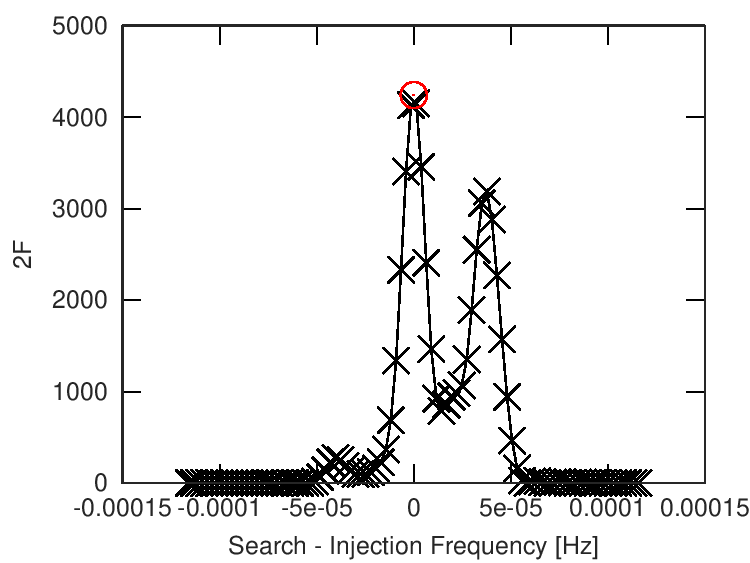Next: ComputeDopplerMetric(), Up: Continuous-Wave Functions [Contents][Index]
DoFstatInjections()DoFstatInjections() creates gravitational-wave data containing a simulated continuous gravitational-wave signal, then searches for them using the F-statistic.
First we define the parameters of the simulated continuous gravitational-wave signal:
octave> Alpha = 3.92; octave> Delta = 0.83; octave> Freq = 200; octave> f1dot = 1e-9;
We then define some common arguments to DoFstatInjections() (see the documentation for details):
octave> Tobs = 86400;
octave> DFIargs = {"ref_time", 731163327, "start_time", 850468953, "time_span", Tobs, "detectors", "H1,L1", "sft_time_span", 1800, "sft_overlap", 0, "sft_noise_window", 50, "inj_h0", 0.55, "inj_cosi", 0.31, "inj_psi", 0.22, "inj_phi0", 1.82, "inj_alpha", Alpha, "inj_delta", Delta, "inj_fndot", [Freq; f1dot], "Dterms", 8, "randSeed", 1234};
We perform a simple search over just frequency, all other parameters being perfectly matched:
octave> dFreq = 0.2 / Tobs;
octave> sch_Freq = linspace(Freq - 50*dFreq, Freq + 50*dFreq, 90);
octave> sch_f1dot = f1dot * ones(size(sch_Freq));
octave> sch_fndot = [sch_Freq; sch_f1dot];
octave> sch_Alpha = Alpha * ones(size(sch_Freq));
octave> sch_Delta = Delta * ones(size(sch_Freq));
octave> res = DoFstatInjections(DFIargs{:}, "det_sqrt_PSD", 1.0, "OrbitParams", false, "sch_fndot", sch_fndot, "sch_alpha", sch_Alpha, "sch_delta", sch_Delta);
If none of the sch_... variables are passed to DoFstatInjections(), it searches at the exact parameters of the injected signal:
octave> res0 = DoFstatInjections(DFIargs{:}, "det_sqrt_PSD", 1.0, "OrbitParams", false);
Finally, we plot the results:
octave> graphics_toolkit gnuplot
octave> plot(res.sch_fndot(1,:) - Freq, res.sch_twoF, "kx-", res0.sch_fndot(1,:) - Freq, res0.sch_twoF, "ro");
octave> xlabel("Search - Injection Frequency [Hz]");
octave> ylabel("2F");
octave> ezprint("DoFstatInjections-plot-1.png", "width", 180, "fontsize", 6);
